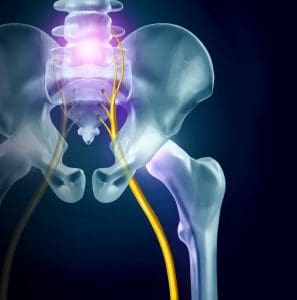 While sciatica pain during pregnancy is rare, some underlying medical conditions may cause or mimic sciatica symptoms. Short walks, heat & ice therapy, pregnancy-safe stretches, and exercise have the potential to alleviate pain and discomfort. Continue reading below to learn more about identifying and managing sciatica pain.
While sciatica pain during pregnancy is rare, some underlying medical conditions may cause or mimic sciatica symptoms. Short walks, heat & ice therapy, pregnancy-safe stretches, and exercise have the potential to alleviate pain and discomfort. Continue reading below to learn more about identifying and managing sciatica pain.
Lumbar radiculopathy, commonly called sciatica, is a term that describes symptoms of pain, numbness, and/or weakness that originate in the lower back and radiate along the sciatic nerve into the buttock, thigh, and leg, sometimes including the foot. Sciatica is uncommon in pregnancy and usually does not occur as a result of the growing fetus or bodily changes that take place at the time. However, the symptoms may be experienced due to other underlying medical conditions.
Read on to learn how sciatica may occur in pregnancy, common types of pregnancy-related pain that may mimic sciatica, and tips for effective sciatica relief while pregnant.
Symptoms of Sciatica
Sciatica is typically characterized by a shooting, searing pain that travels down the buttock into the thigh and leg, sometimes including the foot. The symptoms almost always occur on one side at a time. The affected leg may feel heavy and weak.
Pregnancy sciatica may occur due to herniated discs
When a pregnant woman experiences sciatica, it is most likely due to a herniated disc in her lower spine that affects the spinal nerve roots. This occurrence is rare and may take place in one in 10,000 (less than 1%) pregnancies.
While a herniated disc itself may not develop because of the pregnancy, research suggests that this condition is higher in pregnant women above 30 years of age, which is a common age group for herniated disc problems.
Posterior pelvic pain may mimic sciatica in pregnancy
A common type of pregnancy-related pain—posterior pelvic pain (pelvic girdle pain) may cause symptoms that are similar to sciatica. Posterior pelvic pain is common during pregnancy and may affect up to 76% of pregnant women. This pain may also be experienced up to 2 years after childbirth in 5% to 8.5% of new mothers.
- In posterior pelvic pain, a stabbing, dull, shooting, and/or burning pain may be felt in the posterior pelvic area.
- The pain may extend into the buttock and radiate to the groin and back of the thigh.
- This pain, unlike sciatica, is often impossible to locate precisely and may change in type or area(s) affected as the pregnancy progresses.
The exact cause of posterior pelvic pain is not well understood and the pain may result due to hormonal, metabolic, or other biomechanical changes that occur during pregnancy.
Tips to relieve sciatica during pregnancy
Several home treatments can help relieve sciatica symptoms while pregnant. As a general rule, any new treatment, including oral or topical medication, must be discussed with a doctor before use to reduce the risk of side effects to the growing fetus.
Use heat and ice therapy
When sciatica is acute, ice therapy may help numb the pain and relieve symptoms immediately. Ice therapy works by decreasing pain signals and reducing blood flow and helps relieve inflammation.
For chronic or recurring sciatica, try heat therapy. Application of heat helps dilate blood vessels, improve blood and nutrient flow, and reduce muscular soreness, aiding in the healing process.
Perform pregnancy-safe stretches and exercises
Several stretching and strengthening exercises are safe to perform during pregnancy. Talk to your physical therapist or doctor about starting a home-based exercise program appropriate for your stage of pregnancy.
Exercise helps promote and support proper posture, which is essential to avoiding unnecessary stress to your lower back.
Go for short walks
Walking short distances may improve function and stability in the lower back. The compressive forces that occur on the spinal discs while walking may help supply nutritive fluids to these structures.
If you’re new to walking or any exercise, start with 5 minutes and gradually add 5 to 10 minutes each week, as tolerated. It is important to keep hydrated and prevent overexertion, which can lead to complications. Cycling, stair steppers, ellipticals, swimming, aerobic dance, and yoga are other safe exercise options when performed under the guidance of a medical professional.
Severe motor deficits require immediate medical attention
Fewer than 2% of pregnant women with herniated discs may develop cauda equina syndrome, a medical emergency that causes severe neurological deficits. Common symptoms of cauda equina syndrome include severe weakness and numbness in both legs, loss of sensation in the groin and pubic area, and decreased or complete loss of bowel and/or bladder movements.Cauda equina syndrome must be treated immediately to preserve leg function.
Sciatica and back pain symptoms should always be addressed as quickly as possible and managed throughout the course of pregnancy. While sciatica is not a common occurrence in pregnant women, it is possible, and a good understanding of the underlying cause can help manage the symptoms and prevent recurrences.
Original article published on spine-health.com








